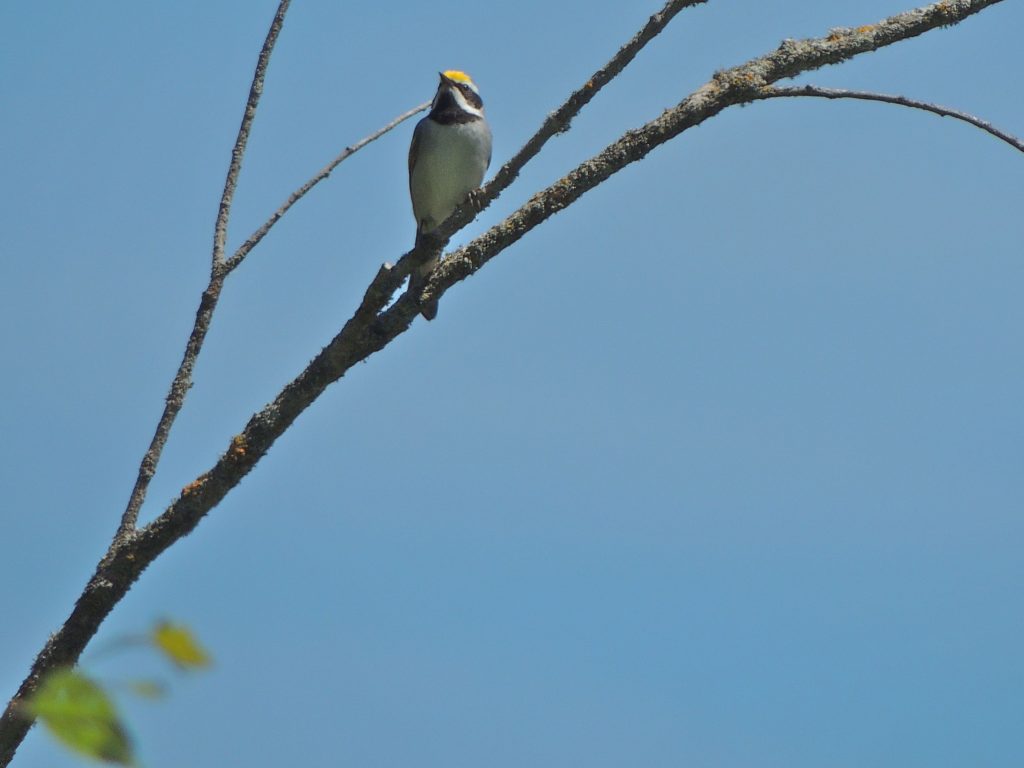June 7 2017 Hartwick Pines State Forest, Michigan. There is absolutely nothing to seeing a Kirtland’s Warbler. They are very rare it’s true, they’re also protected and cosseted so, if you want to see one, just about the only way, certainly the best way to get a glimpse, is to show up just before seven a.m at the visitor centre at northern Michigan’s Hartwick Pines State Park and join the guided tour, it’s free and warbler-encounters pretty well guaranteed. A young naturalist briefs you on the circumstances of the Kirtland’s Warbler’s ecology, history, population crash and subsequent recovery, and then off you go.
You join a car-convoy of birders and in no time at all you’re at a site where Kirtland’s Warblers breed and where males of the species sing lustily. It’s all very easy. That’s what we did today and the only struggle was in actually laying eyes on one, you could hear them all around, often just a few feet away, but the pines, though short, are thick and the birds rarely obvious.
The thing about Kirtland’s Warblers is that there are only about two thousand in the world; about the same as the population of Grayling, the sprawling crossroads of a town closest to the State Forest. They spend the winter in the Bahamas (the birds not the people of Grayling), nest in northern Michigan and make an unaided two-thousand five-hundred kilometre journey twice a year. Such a journey is not particularly extraordinary in the bird world; other species fly the length of the American continents, south to north and back. But what is extraordinary is that the Kirtland’s Warbler came close to extinction. European settlers thought they knew better and catastrophically disrupted a few natural underpinnings of the Kirtlands’ habitat and breeding biology. By the mid 1900s the species’ population fell close to three hundred and it seemed doomed.

To the great credit of Michigan Audubon and the state’s Department of Natural Resources the free-fall has been reversed and the Kirtland’s Warbler seems to be recovering, but it’s still a very rare bird and we were privileged to see it, stage-managed though it was. It was unequivocally Bird of the Day until…
….We went looking for a Golden-winged Warbler and found it too. Truth is we’d heard where we might find them and made our way to an obscure gravel road. We parked in the shade, scratched together some bits and pieces of lunch and then paced up and down, looking, listening and enjoying the time and place. In a half an hour or so of trying we found Chestnut-sided Warblers, American Redstarts, and Hairy Woodpeckers. We were far from discouraged but wondered just a little whether the directions we’d been given were all they were cracked up to be.
Golden-winged Warblers sing after a fashion, it’s really just a short series of buzzes, like a worrisome electrical short; and harder to hear the older you get. But then…there it was overhead and anxious. It stayed in one place just long enough for us to get our binoculars on it and then it zipped across the road looping around to another half-hidden vantage spot. A short maddening pause, long enough for us to spot it and then off again, around and around it went. Eventually we got used to each other and things settled down and we realized there were two of them and they were carrying food to nestlings somewhere nearby.

The sight of a Golden-winged Warbler always makes me catch my breath and it indisputably fits in the category of pretty warblers. It is also in my personal collection of ‘Warblers I never get a decent photo of.” Here’s couple: one above from this day and one below from a year ago. Both lovely to look at but I recommend seeing a real one in the open and sunlit; if it’ll stay still that is.

